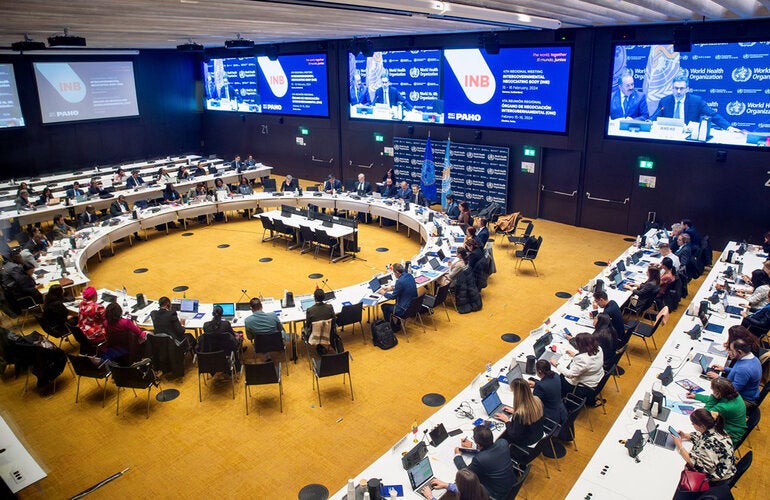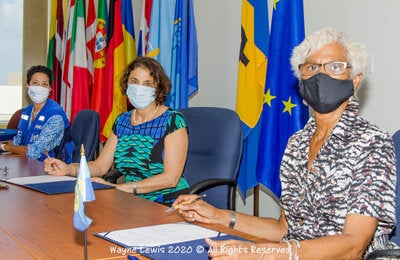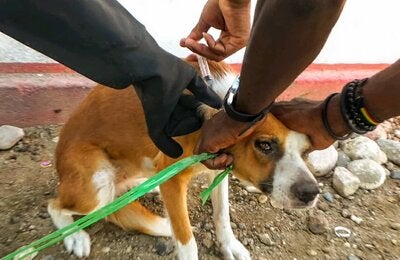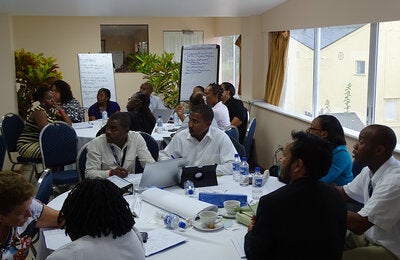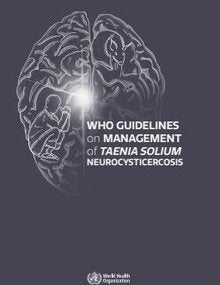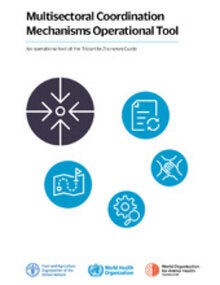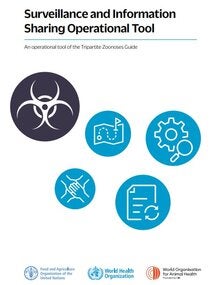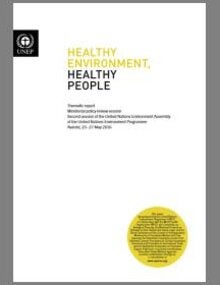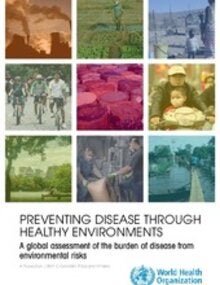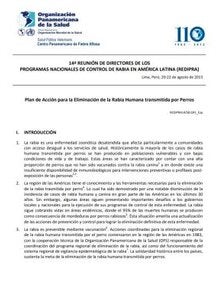One Health is an integrated and holistic approach to address health threats at the animal-human-environmental interface. It aims to sustainably balance and optimize the health of people, animals and ecosystems. By promoting coordination and communication across multiple sectors a One Health approach can achieve better public health outcomes.
One Health recognizes that the health of humans, domestic and wild animals, plants, and the wider environment (including ecosystems) are closely linked and interdependent. Through the linking of humans, animals and the environment, One Health can help to address the full spectrum of disease control – from prevention to detection, preparedness, response and management – and contribute to global health security.
In September 2021, the Directing Council of the Pan American Health Organization (PAHO) endorsed the policy, One Health: a comprehensive approach for addressing health threats at the human-animal-environment interface (CD59/9), that calls for a comprehensive and inclusive approach for the Organization to work with its Member States.
PAHO’s Regional One Health approach is built on six interdependent action tracks[1] that require close collaboration across sectors, stakeholders, and countries. The areas of work include:
Action track 1 “Enhancing One Health capacities to strengthen health systems” is overarching and focuses on strengthening One Health collaborative capacity to support global, regional, and national coordination for the integrated management and regulation of issues at the animal–human–plant–environment interface and to promote the health of humans, animals, plants, and ecosystems.
Several regulatory frameworks, programmes, and initiatives developed and led by the quadripartite organizations (FAO, UNEP, WHO, and WOAH) are relevant. Among them, the International Health Regulations (2005) (IHR) is the only instrument that legally binds Member States with the commitment to develop and maintain the capacity to detect, assess, notify, and report potential emergencies of international concern. The One Health approach is an essential component of the IHR core capacities. By aligning with the principles and requirements of the IHR, countries can enhance their One Health capacities and contribute to global health security. In addition to the IHR, the Essential Public Health Functions provides a framework for building the institutional capacities to strengthen stewardship and governance for stronger health systems with a Primary Health Care Approach to foster the integration of human, animal, and environmental health.
Robust health information infrastructure, high-quality data, and modern digital capabilities can offer critical advantages in enhancing capacities and addressing One Health challenges. By harnessing the power of digital health, including big data analytics and artificial intelligence, and fostering collaboration among various stakeholders, Member States’ capacity to detect, analyze, predict, forecast, and report surveillance data on diseases, Antimicrobial Resistance (AMR), and other health threats is strengthened, ultimately safeguarding the health and well-being of humans, animals, and the environment.
Action track 2, “Reducing the risks from emerging and re-emerging zoonotic epidemics and pandemics,” is an integral component of the efforts by PAHO, Member States, and international partners to enhance surveillance, preparedness, and response to pathogens with epidemic and pandemic potential. As most of these pathogens have an animal reservoir and vector, these efforts must be conducted at the human-animal-environmental interface. The Region of the Americas is at great risk for the emergence and reemergence of zoonotic pathogens, and the spillover risk to human populations is ever-increasing because of factors such as the encroachment of human settlements in sylvatic areas, unplanned urbanization, and the potential impact of climate change and more frequent extreme weather events.
Along the human-animal-environmental interface, PAHO works together with Member States and international partners to develop and implement preparedness and response plans, epidemiologic/virologic/genomic surveillance systems, laboratory diagnostic and reference services and their networking, biosafety and biosecurity, and capacities on clinical management and infection prevention and control. In addition, PAHO forecasts and characterizes infection and disease risks, including in potential animal and wildlife reservoirs, and develops evidence-based strategies to predict, prevent, detect, and respond to zoonotic hazards. All these actions are also achieved through expert networks to leverage international expertise and to foster regional knowledge-sharing and collaboration, as well as by providing secretariat support to regional and global initiatives.
Action track 3, “Controlling and eliminating endemic zoonotic, neglected tropical and vector-borne diseases,” focuses on the prevention, surveillance, control, and elimination of Neglected Infectious Diseases (NIDs). Since most of NIDs are zoonotic diseases, to tackle them, it is essential to promote the intersectoral coordination and integration of strategies and interventions within the human-animal-environmental interface, in line with the One Health approach, and ensuring efficiency, effectiveness and sustainability.
PAHO promotes the coordination and integration of strategies aimed at humans (diagnosis and early and adequate treatment), and vectors, including management of the environment to reduce its proliferation and interventions among animal reservoirs. Therefore, there are promoted and applied intersectoral and integrated actions to address all aspects of the neglected zoonotic tropical diseases (NTZD) in the endemic countries, which implies working on national and regional policies.
Action track 4 “Strengthening the assessment, management and communication of food safety risks” focuses on the prevention and control of foodborne illnesses. The safety of food is inextricably linked to where it is grown (environment), how it is grown (human-animal-environment interaction) and, how it is consumed (human interaction). Humans need safe food and water to maintain their vital functions. Food safety cannot be conceived without a One Health approach and countries need to develop an integrated approach to prevent any risks emerging along the food value chain “from farm to fork”.
Promoting intersectoral coordination at the regional, national, and local levels is essential for the implementation of effective and sustainable strategies to promote food safety, considering the health of humans, animals, and the environment throughout the entire food chain, from production to consumption. Food Safety strategies need to be underlined by risk analysis principles to scientifically assess potential food safety risks, manage the identified risks effectively, and communicate those risks adequately to industry, consumers, and trade partners.
Action track 5 “Curbing the silent pandemic of antimicrobial resistance” focuses on addressing the growing problem of antimicrobial resistance (AMR) in humans, animals, and the environment. The use of antimicrobials in humans and animals, along with environmental contamination, contributes to the emergence and spread of resistant microorganisms in multiple sources. Inadequate living conditions, limited access to clean water and sanitation, poor hygiene practices, and improper waste management further accelerate the development and dissemination of resistant genes and pathogens among humans, animals, and the environment. AMR has multiple drivers and needs to be tackled on many fronts, a One Health approach is essential to ensure that all sectors and stakeholders communicate and work effectively together. By implementing comprehensive strategies to address the AMR problem with a One Health vision, such as National AMR Action Plans, we can curb the emergence and spread of AMR.
Action Track 6 “Integrating the environment into One Health” focuses on how the environment may affect the living conditions of populations and the different productive, economic and social activities.
Recent global changes in social-ecological systems have created an environment that favors the emergence and spillover of pathogens. Environmental determinants of health, including unsafe water, sanitation, and hygiene services, climate change, as well as air pollution and mismanagement of chemicals such as pesticides and mercury, adversely affect the health of humans, animals, and plants. Additionally, microplastics, chlorinated derivatives, pesticides and nitrogen derivatives act as environmental stressors and their accumulation throughout the food chain affects and endangers human health. Access to safely managed water and sanitation is a preventive barrier that keeps humans from contracting certain infectious diseases, to the extent that people can practice frequent hand washing and eliminate the practice of open defecation.
The environment is a crucial sector in the One Health triad which includes human and animal health. Therefore a coordinated, multipronged systems approach focused on understanding the linkages and interactions is necessary for the advancement of One Health.
WHO is a member of the One Health Quadripartite along with the Food and Agriculture Organization, World Organization for Animal Health and United Nations Environment Programme. The four organizations work together to promote multisectoral responses to public health threats originating in the animal-human-environment interface and to provide technical advice on how to reduce these risks.
At the 28th Tripartite Executive Annual Meeting (TEAM28) in March 2022, a Memorandum of Understanding was signed by the principals of the four organizations, expanding the Tripartite to form the Quadripartite, with the inclusion of the United Nations Environment Programme (UNEP).
[1] Based on the six action tracks of the Quadripartite OH Joint Action Plan.








